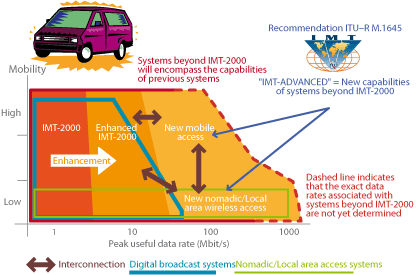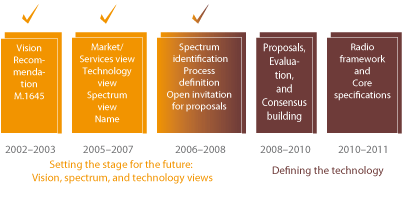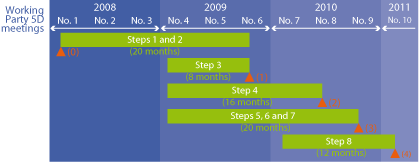|
Development of IMT-Advanced: The SMaRT approach
Stephen M. Blust, Chairman of ITU–R Working Party 5D
and Director of Radio Standards, AT&T, Inc.
What is IMT-Advanced?
International Mobile Telecommunications-Advanced (IMT-Advanced) systems are mobile systems which include the new capabilities of IMT that go beyond those of IMT-2000. Such systems will provide access to a wide range of telecommunication services (including advanced mobile services), supported by mobile and fixed networks that are increasingly packet-based. In other words, IMT-Advanced (or 4G) will see a progression beyond third-'generation (3G) technology.
IMT-Advanced systems will support low to high mobility applications and a wide range of data rates in accordance with user and service demands in multiple user environments. IMT-Advanced also has capabilities for high-quality multimedia applications within a wide range of services and platforms providing a significant improvement in performance and quality of service. This is depicted by what has been referred to as the “Van Diagram” (see Figure 1) adapted from Recommendation ITU–R M.1645 developed by ITU’s Radiocommunication Sector (ITU–R).
|
Figure 1 — The “VAN diagram”...
|
|

|
As defined in Resolution ITU–R 56, both IMT-2000 and IMT-Advanced are known collectively by their root name of IMT. And ITU is the internationally recognized entity tasked with defining the next generation(s) of global wireless technologies through its work on IMT.
ITU–R is on track in its work towards completing the full set of documentation for this definition. It held consultations with the global community over many years on this topic in Working Party 8F, under the scope of a work item known as Question ITU–R 229-1/8 “Future development of IMT-2000 and systems beyond IMT-2000”. A number of key Recommendations and Reports have already been released that document IMT-2000 and set the stage for IMT-Advanced.
Following the Radiocommunication Assembly in 2007 (RA-07), the work on IMT is now being addressed under the new Study Group 5 umbrella by Working Party 5D. RA-07 revised the original study question, now called Question ITU–R 229-2/5 “Future development of the terrestrial component of IMT”, to include both responsibility for the continued development and enhancement of IMT-2000 and the mandate to address all aspects of IMT-Advanced. This Question, along with related Resolutions of RA-07 and of the World Radiocommunication Conference in 2007 (WRC-07), establishes the continuation of this critical work on IMT.
Based on an open process, Working Party 5D has established a road map for the future beyond 3G mobile communications that is comprised of a balance among spectrum, market and services, and technology aspects. These, along with regulatory aspects, are the key elements to support the success of mobile wireless deployments and to meet users’ needs. In 2008, Working Party 5D completed work on the near-term steps of IMT-Advanced by agreeing the process, timelines and requirements. In this work, ITU–R has the full support of the global wireless industry and administrations, and the important partnership between ITU–R and industry (under the auspices of Resolution ITU–R 9-3) is flourishing.
The SMaRT view of the work
“SMaRT” is an acronym for the four essential and interrelated dimensions needed to support wireless information and communication technologies (ICT). These elements are:
- SPECTRUM — which is the natural resource of wireless communications.
- MaRKETPLACE — which includes users’ needs and demand for services and the economic driver for business models.
- REGULATORY — which encompasses the authorization to use spectrum and provides controls to ensure that the natural resource is shared properly among the licensees.
- TECHNOLOGY — which provides the ability to use spectrum for the services and capabilities required by the marketplace, in accordance with the regulatory criteria.
Each of these elements is necessary and all must be addressed collectively at the international, regional and national levels.
|
Figure 2 — Progression towards IMT-Advanced
|
|
 |
How has ITU–R and the industry addressed the SMaRT concept in the work on IMT-Advanced? In their consideration of IMT-Advanced, Working Party 5D and its predecessor Working Party 8F have developed goals that address all the dimensions of the SMaRT factors. These are illustrated in Figure 2.
The process of developing IMT-Advanced
ITU–R is tying all the SMaRT factors together through the development of a comprehensive and interrelated set of Recommendations and Reports that are defining the next level of wireless communication capabilities for global deployment under the scope of an IMT-Advanced process and timelines.
Some foundation achievements by ITU–R that illustrate the SMaRT concept as it has been applied to the work on IMT-Advanced are listed in Table 1. These documents can also be consulted for a deeper understanding of IMT-Advanced.
|
Table 1 —
Applying the SMaRT concept to work on IMT-Advanced
|
|
Spectrum aspects |
| |
Recommendation ITU–R M.1768 Methodology for calculation of spectrum requirements for the future development of the terrestrial component of IMT-2000 and systems beyond IMT-2000
Report ITU–R M.2078 Estimated spectrum bandwidth requirements for the future development of IMT-2000 and IMT-Advanced
Report ITU–R M.2079 Technical and operational information for identifying spectrum for the terrestrial component of future development of IMT-2000 and IMT-Advanced |
|
Marketplace and user needs aspects |
| |
Recommendation ITU–R M.1645 Framework and overall objectives of the future development of IMT-2000 and systems beyond IMT-2000
Recommendation ITU–R M.1822 Framework for services delivered by IMT
Report ITU–R M.2072 World mobile telecommunication market forecast
|
|
Regulatory aspects |
| |
Recommendation ITU–R M.1036 Frequency arrangements for implementation of the terrestrial component of International Mobile Telecommunications-2000 (IMT-2000) in the bands 806–960 MHz, 1 710–2 025 MHz, 2 110–2 200 MHz and 2 500–2 690 MHz
Resolution ITU–R 56 Naming for International Mobile Telecommunications
Reports ITU–R M.2109, M.2110, M.2111, and M.2112 (IMT-related sharing studies covering various bands and technologies)
|
|
Technology aspects |
| |
Resolution ITU–R 57 Principles for the process of development of IMT-Advanced (Question ITU–R 229/8)
Report ITU–R M.2038 Technology Trends
Report ITU–R M.2074 Radio aspects for the terrestrial component of IMT-2000 and systems beyond IMT-2000
Report ITU–R M.2133 Requirements, evaluation criteria, and submission templates for the development of IMT-Advanced
Report ITU–R M.2134 Requirements related to technical system performance for IMT-Advanced radio interface(s)
Report ITU–R M.2135 Guidelines for evaluation of radio interface technologies for IMT-Advanced |
|
Invitation to IMT-Advanced
It is important to note that ITU–R has announced to its members and industry the details for the first release of IMT-Advanced. The first invitation for the submission of proposals for candidate radio interface technologies (RITs), or a set of RITs (SRITs), for the terrestrial components of IMT-Advanced was issued with ITU–R Circular Letter 5/LCCE/2 released on 7 March 2008. This initiated an ongoing process to evaluate the candidate RITs or SRITs for IMT-Advanced, and invites the formation of independent evaluation groups and the subsequent submission of evaluation reports on these candidate RITs or SRITs.
The Circular Letter also announces specific requirements for IMT-Advanced technologies, defines the way forward for submission of candidate radio interface technologies, sets out the criteria and methods for evaluation and communicates a set time-frame for this work. Within this time-frame, the work of Working Party 5D on IMT-Advanced (in conjunction with the relevant external organizations) is outlined in Figure 3.
|
Figure 3 — The work of Working Party 5D on IMT-Advanced
|
|
 |
|
Steps in radio interface development process
|
|
Step 1
|
Issuance of the circular letter
|
|
Step 2
|
Development of candidate RITs and SRITs
|
|
Step 3
|
Submission/Reception of the RIT and SRIT proposals and acknowledgement of receipt
|
|
Step 4
|
Evaluation of candidate RITs and SRITs by evaluation groups
|
|
Step 5
|
Review and coordination of outside evaluation activities
|
|
Step 6
|
Review to assess compliance with minimum requirements
|
|
Step 7
|
Consideration of evaluation results, consensus building and decision
|
|
Step 8
|
Development of radio interface Recommendation(s)
|
|
|
Critical milestones in radio interface development process
|
|
(0)
|
Issue an invitation to propose RITs
|
March 2008
|
|
(1)
|
ITU proposed cut off for submission of candidate RIT and SRIT proposals
|
October 2009
|
|
(2)
|
Cut off for evaluation report to ITU
|
June 2010
|
|
(3)
|
Working Party 5D decides framework and key characteristics of IMT-Advanced RITs and SRITs
|
October 2010
|
|
(4)
|
Working Party 5D completes development of radio interface specification Recommendations
|
February 2011
|
|
Communicating the work
In addition to the usual means of disseminating ITU–R Recommendations and Reports related to work on IMT (via ITU’s Publications Department and through the release of Circular Letters on IMT-Advanced), a specific ITU–R webpage has been established to provide a convenient portal to the process. This portal is available at:
www.itu.int/ITU-R/go/rsg5-imt-advanced
In furthering the work on IMT-Advanced and to facilitate the start of consensus building in the process, ITU–R has held open workshops on the topic. The first of these was held in May 2007 in Kyoto, Japan, and addressed the conceptual views and the status of research activities in the industry. The most recent workshop was on 7 October 2008, in Seoul, Republic of Korea, and focused on an exchange of information on the timelines, process, requirements for technical performance, evaluation guidelines, and submission templates for IMT-Advanced standardization. Details were also forthcoming of possible candidate IMT-Advanced radio interface techniques, as expressed by some of their proponents. Additionally, this workshop recognized the ongoing role of wireless technologies and services in developing countries and addressed this in some depth in the context of both IMT-2000 and IMT-Advanced.
Assisting communications in developing countries
The input of developing countries has been, and continues to be, important in the creation of IMT-Advanced. The work on IMT conducted in ITU’s Telecommunication Development Sector (ITU–D) — in particular ITU–D Study Group 2 Question 18-1/2 — has been important in encouraging developing countries to participate in the 'process, as well as in addressing the evolution of mobile networks to IMT through guidelines and handbooks on the topic. In addition to the role played by ITU–D, various regional telecommunication organizations have objectives related to IMT in developing countries and are incorporating these needs into the development of technologies for IMT-Advanced.
It must be reiterated that IMT systems do not need to be specially designed for developing countries, and that any unique needs have proved to be readily accommodated. One such additional requirement, of special importance to IMT for developing countries, is the focus on extending the technologies to operate in lower frequency bands (such as 450 MHz and UHF) to enable cost-effective support for large areas of low population density by deploying IMT radio systems with a very large cell radius. These particular needs have been taken on board from the start in the requirements for IMT-Advanced; candidate technologies are expected to be able to operate in the low frequency IMT bands on narrower radio channels, as well as in the higher frequency IMT bands where much wider channels can be made available.
It is encouraging to note the rapid adoption of mobile service in developing countries, and that there has been significant growth in broadband Internet access. The ability of technologies such as IMT to enable readily available and affordable communications supports ITU’s effort to “connect the unconnected by 2015”.
Conclusion
ITU–R initiated a future vision more than 15 years ago and, working in close partnership with industry, developed it into IMT-2000 which has become the basis of third-generation mobile communications systems. While IMT-2000 continues to evolve, it is now time to finalize the direction for the next major era of wireless communications. The 3G systems employing IMT-2000 have been in deployment for eight years. They are maturing and are achieving their objective of providing worldwide communications for voice and high speed data transmission — the fulfilment of the initial IMT-2000 vision.
To set the stage for the new wireless future, in 2003 ITU–R once again provided a further strategic vision of how the needs of the marketplace and end users could evolve. That vision is called IMT-Advanced. As importantly, ITU–R has now set in place a plan to achieve this vision. The plan and its related Recommendations and Reports define the IMT future through the ongoing development of IMT-Advanced.
The requirements for IMT-Advanced are a significant milestone in capability when compared to those of IMT-2000. IMT-Advanced is a leap beyond. It offers new capabilities for the physical layer of the radio interface and brings into play a greater level of radio resource management and control, advanced capabilities for spectrum channel and bandwidth aggregation, and improved performance at all levels, including quality of service aspects. IMT-Advanced represents a wireless telecommunication platform that has the flexibility to accommodate services that are yet to be imagined.
The release of IMT-Advanced Recommendations for detailed technical specifications is anticipated in early 2011, following the receipt of candidate technology submissions throughout 2009 and their evaluation during 2010. Thus, in 2011, IMT-Advanced will move from concept into reality. The subsequent deployment of IMT-Advanced systems will then establish yet another pinnacle in the advancement of ICT in all regions of the world.
As might be expected, in a mobile industry that is likely to be serving 4 billion users by the end of 2008, interest in the next-generation wireless system remains high among the members of ITU–R and global industry at large. ITU–R Working Party 5D continues to drive progress on all aspects of IMT-Advanced; the evolution of the current IMT-2000 third-generation systems of today are a stepping stone into this bright future.
The work on IMT-Advanced is on track to meet the market time-frames and exceed users’ expectations. It is an example of the strategic role that ITU plays in the development and global standardization of wireless systems built upon the latest technologies.
|


